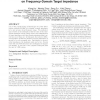Free Online Productivity Tools
i2Speak
i2Symbol
i2OCR
iTex2Img
iWeb2Print
iWeb2Shot
i2Type
iPdf2Split
iPdf2Merge
i2Bopomofo
i2Arabic
i2Style
i2Image
i2PDF
iLatex2Rtf
Sci2ools
SLIP
2009
ACM
2009
ACM
On the bound of time-domain power supply noise based on frequency-domain target impedance
One of the popular design methodologies for power distribution networks (PDNs) is to identify a target impedance to be met across a broad frequency range. The methodology is based on the assumption that the ratio of the timedomain maximum output voltage noise to the multiplication of target impedance and time-domain maximum input current is no more than one. In this paper, the ratios for different impedance profiles are analyzed, and the assumption is proved to be not necessarily true. Particularly, for secondorder impedances, the maximum ratio can be two. Several cases with real PDN structures are investigated to support our analysis. A real case of the complete PDN path with
Computer Networks | Maximum Output Voltage | SLIP 2009 | Target Impedance | Time-domain Maximum Input |
| Added | 28 May 2010 |
| Updated | 28 May 2010 |
| Type | Conference |
| Year | 2009 |
| Where | SLIP |
| Authors | Xiang Hu, Wenbo Zhao, Peng Du, Yulei Zhang, Amirali Shayan Arani, Christopher Pan, A. Ege Engin, Chung-Kuan Cheng |
Comments (0)

